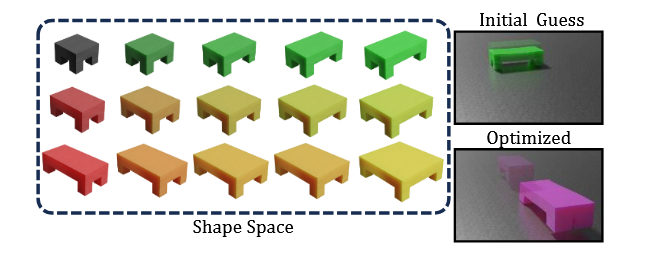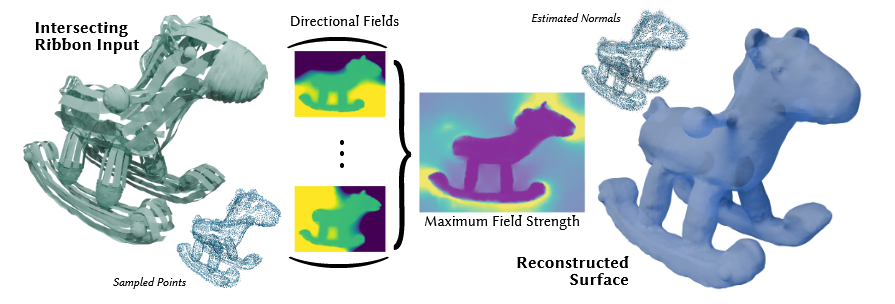
UBC Computer Science researchers win multiple Best Paper Awards at SIGGRAPH conference and symposium
From papers to workshops to short courses, UBC Computer Science shines at the world's premier computer graphics and interactive techniques conference
UBC Computer Science faculty and students joined other researchers, scientists, artists, filmmakers and business professionals at the SIGGRAPH (Special Interest Group on Computer Graphics and Interactive Techniques) conference in Vancouver from August 10-14, 2025.
This year, the department made a splash with papers, posters, workshops and short courses.
Dr. Alla Sheffer, UBC Computer Science postdoctoral fellow Congyi Zhang and collaborators introduced a new method of generating 3D models that allows for more control over editing each component in the model in the paper “CMD: Controllable Multiview Diffusion for 3D Editing and Progressive Generation.” Not only does their model allow for more editing flexibility, but it also generates higher quality 3D models and is more computationally efficient.

UBC Computer Science professor Dr. Peter Yichen Chen and collaborators introduced a new neural representation called “Wind Lifter,” which accurately models complex cuts in deformable structures with thin walls, such as handcrafting delicate shapes with scissors. The paper, “Lifting the Winding Number: Precise Representation of Complex Cuts in Subspace Physics Simulations,” details the method that allows for generalizable, precise and easy editing of representations that may be discontinuous. This paper was presented at the conference and won Best Paper Award Honourable Mention.

Dr. Chen and collaborators also introduced a method and representation for eigenmodes over shape space, which allows efficient analysis of any shape. The method is detailed in the paper “Shape Space Spectra” and is the first of its kind, helping to evaluate and optimize design solutions for shapes that are constrained by physics, such as the aerodynamics of airplane wings and the flexibility of plastic forks. This paper was presented at the conference and won Best Paper Award.

Incoming graduate student Daniel Cui (Dr. Sheffer’s group) and collaborators at Boston University proposed a new method called “Faraday cage estimations (FaCE)” to estimate unoriented sets of data points. This method, detailed in the paper “Faraday Cage Estimation of Normals for Point Clouds and Ribbon Sketches,” allows researchers to probe underlying geometric shapes and reconstruct them. This paper won Best Paper Award Honourable Mention.

Furthermore, several UBC Computer Science faculty members participated in several workshops, including one organized by Dr. Chen entitled “Reduced-Order Modeling for Physical Simulation: From the Classical to the Neural" and one in which Dr. Michiel van de Panne was a speaker, entitled “Generalizing Natural Behavior: Retargeting Human or Animal Motion to Robotic Forms."
Dr. Chen also helped to organize the course Graphics4Science: Computer Graphics for Scientific Impacts while Dr. Tamara Munzner lectured on Visualization Analysis and Design.
UBC Bachelor of Computer Science (BCS) student Delsther James Edralin and collaborators from the UBC Emerging Media Lab are presented a poster entitled, “Evaluating the Effectiveness of Configurable Virtual Reality System for Multi-sensory Spatial Audio Training," on using virtual reality for auditory localization training.
At the SIGGRAPH Symposium on Computer Animation 2025 (SCA 2025), Dr. van de Panne was a keynote speaker with a talk entitled, “How to train your character in the AI era,” which examines the role of example data and reinforcement learning in design patterns. UBC Computer Science also presented two papers and two posters at the symposium:
Papers:
Walk This Way: Imitation-free Reinforcement Learning of Flexibly-Constrained Walking Controllers
Tiffany Matthé, Nicholas Ioannidis and Michiel van de Panne
Diffusion-based Planning with Learned Viability Filters
Nicholas Ioannidis, Daniele Reda, Setareh Cohan and Michiel van de Panne
Posters:
Learning Action Chunks for Motor Control
Ruiyu Gou, Michiel van de Panne
Learning Simulatable Models of Cloth with Spatially-varying Constitutive Properties
Guanxiong Chen, Shashwat Suri, Yuhao Wu, Etienne Vouga, David I.W. Levin, Dinesh K. Pai